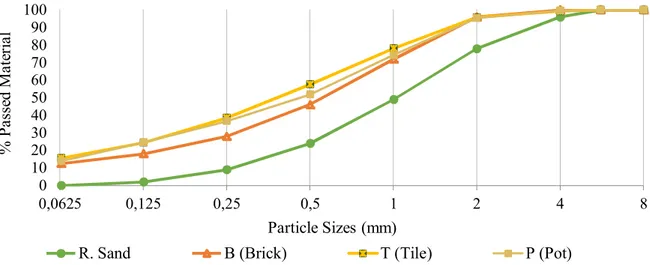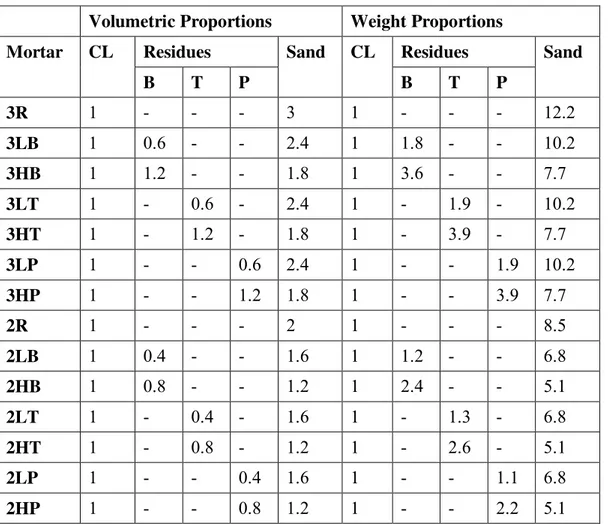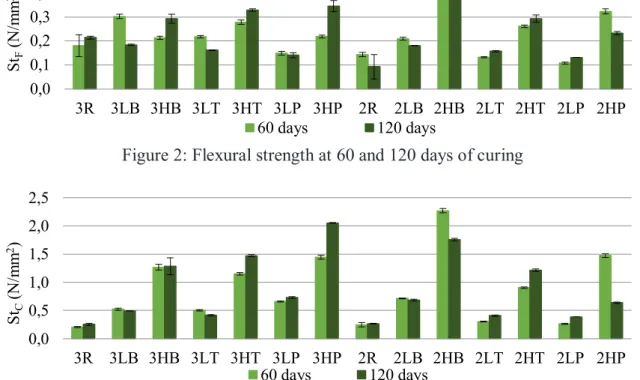CHARACTERIZATION OF MORTARS WITH CERAMIC RESIDUES
Matias, G. (1), Torres, I. (2) and Faria, P. (3)
(1) ITeCons, Coimbra - Portugal, ginamatias@itecons.uc.pt (2) DEC - FCTUC, Coimbra – Portugal, itorres@dec.uc.pt (3) DEC – FCT UNL, Lisboa – Portugal, paulina.faria@fct.unl.pt
Abstract
Mortar coatings are usually the first elements to deteriorate, once they are the most exposed construction elements. Taking into account their protective function, it is easily understood the importance of the development of a correct conservation / rehabilitation intervention.
Old mortars were essentially air lime based and their rehabilitation must be executed with compatible mortars, so that they not only recover the protective function, but also contribute to maintain the integrity of the whole wall-render element and the aesthetic image of the building.
As it is known, many old lime-based mortars had ceramic residues in their composition, which are very abundant residues, particularly in Portugal. Thus, in an attempt to combine the interest of reusing waste ceramic, reducing the amounts that are typically landfilled, with the technical benefits that they can bring to rehabilitation mortars, experimental research has been developed, at the University of Coimbra, in collaboration with the NOVA University of Lisbon, on the behavior of lime mortars with incorporation of ceramic residues.
In this paper, it is presented a comparison between air lime mortars with ceramic residues with volumetric proportions of 1:3 and 1:2 (binder:aggregate), showing the advantages of the reintroduction of the ceramic residues into the productive chain. Studied mortars revealed a quite satisfying behavior as the inclusion of ceramic residues may improve the characteristics of common air lime mortars.
1 INTRODUCTION
different functions, being the most common, especially during Roman Empire, the water proofing requirement. They were largely used for baths, tanks and aqueduct coverings [1].
High specific surface of ceramic dust and high amounts of silica and alumina in the amorphous phase are the main factors that potentiate pozzolanic reactions. The use of ceramic dust may allow to reduce the content of binder in mortars, as it improves their behavior. This will bring benefits from the environmental point of view, once it may enhance a reduction on the exploitation of natural resources and also on the emission of carbon dioxide from the production of binders.
As aggregate, and with adequate particle’s size distributions for mortar’s preparation and similar to commonly used sand, ceramic residues allow a significant reduction in the extraction of natural resources. It has been verified, especially in cement mortars, that this substitution improves their behavior [2]. It must be considered, however, that the characteristics of the aggregate greatly affect the performance of the mortars: roundness, angularity and texture of the grains conditions the binding structure and, consequently, the workability on fresh state and the water amounts required [3]. In hardened state, particles’ distribution has impact especially on mortars´ microstructure and mechanical behavior [4]. Using this type of materials as aggregate replacer might contribute for the reduction of natural resources consumption and, consequently, prevent hazardous environmental impacts caused by natural sand’s extraction.
To the development of this experimental work, three types of residues from ceramic industries of the central region of Portugal were selected. These industries produce ceramic bricks, roof tiles and decorative pots. According to producers’ information, calcination temperatures usually go around 900ºC, in the case of bricks and roof tiles, to 1100ºC in the case of decorative pots. But the period of time at the highest temperature may be restricted. Residues were milled and the resultant material, considered as adequate after particle’s size distribution characterization, was incorporated in air-lime mortars as a partial substitute of the aggregate. This paper presents the results of an experimental campaign developed with mortars with 1:2 and 1:3 volumetric proportions of binder and aggregate. Results from tests performed after 60 days and 120 days of curing are presented: mechanical strength, water vapor permeability and water absorption due to capillary action.
With this work it is intended to enlarge the knowledge about ceramic residues’ incorporation in mortars for repair / rehabilitation purposes or, eventually, for actual construction, considering particularly their durability and longevity. It is expected to obtain compositions with improved behavior reusing materials that are considered waste and disposed into landfills, contributing, in this way, for a more sustainable construction.
2 EXPERIMENTAL PROCEDURE
2.1 Materials characterization
Mortars were prepared using hydrated powder air lime as binder, a river sand and ceramic residues.
933-1:1997 and the obtained results are presented in Figure 1. Loose bulk density was also determined to allow weight proportions’ evaluation. Values obtained for lime, sand and for each one of the ceramic residues, determined according to EN 1097-3:1998, are presented in Table 1.
Figure 1: Ceramic residues and sand’s particle size distribution
Analyzing Figure 1 it can be noticed that the particle’s size distribution of the residues, after being crushed, is quite similar to the one of the river sand. They only differ because residues contain about 10% of particles under 0.063mm, while smaller particles from river sand are almost residual.
Table 1: Loose bulk density, b, of the materials
Material Brick (B) Tile (T) Pot (P) River Sand CL
b (Mg/m 1.10 1.17 0.99 1.54 0.36
In what concerns to loose bulk density of the dry materials all residues present quite similar values, lower than river sand. Air lime bulk density has the lowest value obtained.
2.2 Mortars characterization
Several mortars’ compositions were prepared with the materials described above. Volumetric proportions considered were 1:3 and 1:2 (binder/aggregate) and corresponding mortars were attributed prefixes 3 and 2, respectively. For each type of residue, 20% and 40% of the natural sand was replaced - mortars with 20% of sand’s substitution were designated with an L (Low) and mortars with 40% of sands substitution were designated with an H (High). Mortars with brick residues were attributed B suffix, mortars with tile sharks, T, and mortars with decorative pot were attributed a P. Besides the indicated compositions, two reference mortars without residues were also prepared and they were referenced with an R. These mortars allowed the evaluation of the influence of each residue, as well as the influence of the substitution percentages.
0 10 20 30 40 50 60 70 80 90 100
0,0625 0,125 0,25 0,5 1 2 4 8
%
P
as
se
d
M
at
er
ia
l
Particle Sizes (mm)
All mortars were prepared with water amounts that allowed a consistency in fresh conditions of 135-165 mm, a range that assure workability to this type of lime-based mortars. This parameter was determined according to EN 1015-3:1999 standard (flow table method). Water/binder proportions were also determined and results are presented in Table 2. Table 3 indicates the volumetric and weight proportions of the mortars.
Table 2: Water/binder ratio (w/b) by weight and flow table consistency (fv)
Mortar 3R 3LB 3HB 3LT 3HT 3LP 3HP 2R 2LB 2HB 2LT 2HT 2LP 2HP
w/b 2.85 2.21 2.56 2.62 2.35 2.35 2.63 1.66 1.66 1.87 1.66 1.66 1.66 1.51
fv 147.6 150.8 152.9 151.3 153.2 151.4 151.0 164.8 152.4 164.3 163.1 148.2 149.2 156.1
Table 3: Volumetric and weight proportions
Volumetric Proportions Weight Proportions
Mortar CL Residues Sand CL Residues Sand
B T P B T P
3R 1 - - - 3 1 - - - 12.2
3LB 1 0.6 - - 2.4 1 1.8 - - 10.2
3HB 1 1.2 - - 1.8 1 3.6 - - 7.7
3LT 1 - 0.6 - 2.4 1 - 1.9 - 10.2
3HT 1 - 1.2 - 1.8 1 - 3.9 - 7.7
3LP 1 - - 0.6 2.4 1 - - 1.9 10.2
3HP 1 - - 1.2 1.8 1 - - 3.9 7.7
2R 1 - - - 2 1 - - - 8.5
2LB 1 0.4 - - 1.6 1 1.2 - - 6.8
2HB 1 0.8 - - 1.2 1 2.4 - - 5.1
2LT 1 - 0.4 - 1.6 1 - 1.3 - 6.8
2HT 1 - 0.8 - 1.2 1 - 2.6 - 5.1
2LP 1 - - 0.4 1.6 1 - - 1.1 6.8
2HP 1 - - 0.8 1.2 1 - - 2.2 5.1
remained for two more days in 20ºC and 65% HR and were demolded. They remained in these standard conditions until the ages of test - 60 and 120 days. The incorporation of ceramic residues also acted as a natural pigment and the mortars became slightly reddish colored.
2.3 Mechanical strengths
Flexural and compressive strength were determined according to EN 1015-11:1999/A1:2006 standard specifications. For this purpose, three prismatic specimens were tested, for each sample and curing period. Compressive strength resistance was determined with one of the halves resultant from flexural strength tests. Flexural strength results are indicated in Figure 2 and compressive strength results are presented in Figure 3. Standard deviation is also graphically represented.
Figure 2: Flexural strength at 60 and 120 days of curing
Figure 3: Compressive strength at 60 and 120 days of curing
It was observed that flexural and compressive strength did not present a significant increase through time, except for most of the mortars with high percentages of residues. All mortars with high percentage of residues clearly revealed higher strength and this difference was more evident for 1:2 mortars. In all cases, mortars with ceramic waste register higher strength than the reference mortars, 3R and 2R.
2.4 Water absorption due to capillary action
Water absorption due to capillary action was determined according to EN 15801:2009 standard, appropriate to slow curing mortars, such as air lime ones. One of the two resultant
0,0 0,1 0,2 0,3 0,4 0,5 0,6
3R 3LB 3HB 3LT 3HT 3LP 3HP 2R 2LB 2HB 2LT 2HT 2LP 2HP
StF
(N
/m
m
2)
60 days 120 days
0,0 0,5 1,0 1,5 2,0 2,5
3R 3LB 3HB 3LT 3HT 3LP 3HP 2R 2LB 2HB 2LT 2HT 2LP 2HP
StC
(N
/m
m
2)
halves from flexural tested specimens was used and weightings were carried out at 5, 10, 15, 30, 60, 90, 120, 180 minutes and each 24 hours after a first contact of the specimens with the water slide; the test went on until constant mass was reached. Water absorption coefficient and corresponding standard deviation are represented in Figure 4.
Figure 4: Capillary coefficient at 60 and 120 days
All mortars obtained quite uniform values. Differences observed are very slight; however, higher capillary coefficients correspond to mortars with higher percentages of residues.
2.5 Water vapor permeability
Circular specimens used to determine water vapor permeability had an approximated diameter of 100 mm and thickness of 17mm. The procedure indicated by ISO 12572:2001 standard was followed and the wet cup method was selected. Figure 5 presents the water vapor diffusion-equivalent air layer thickness values, Sd, which allows thickness evaluation of an equivalent air layer in terms of water vapor resistance.
Also for water vapor diffusion-equivalent air layer thickness significant differences between mortars were not verified. Mortars with higher water vapor resistances are the ones with higher percentage of residues, despite these differences are very slight, and all mortars obtained lower values than equivalent reference ones. In what concerns to binder:aggregate proportions, results were quite similar and no evolution related to curing period seemed to occur.
Figure 5: Water vapor diffusion-equivalent air layer thickness
0,0 0,5 1,0 1,5 2,0 2,5 3,0 3,5
3R 3LB 3HB 3LT 3HT 3LP 3HP 2R 2LB 2HB 2LT 2HT 2LP 2HP
C
C
(k
g/
(m
2.m
in
0.
5))
60 days 120 days
0,0 0,1 0,2 0,3
3R 3LB 3HB 3LT 3HT 3LP 3HP 2R 2LB 2HB 2LT 2HT 2LP 2HP
Sd
(m
m
)
3 DISCUSSION
In what concerns to mechanical behavior, the increase of flexural and compressive strengths with the increase of the percentage of ceramic residues might be related with two aspects: in one hand, the increase of residues, which contain 10% more fines than common sand, reduces the porosity of the mortars due to filling of pores; on the other hand, the presence of fine ceramic particles may develop pozzolanic reactions with the binder, also leading to the increase of strength. This hypothesis is reinforced with the fact that mortars with 1:2 (binder:aggregate) proportion present more expressive differences between samples with lower and higher substitution percentages. The fact that all mortars present higher strengths than corresponding reference ones may also be related with the aggregates’ shape. Substituting common siliceous sand, rounder shaped, for ceramic fragments, generally more angular and rough, might contribute to the increase of the binder-aggregate cohesion.
Mortars 3LT, 2HB and 2HP presented a decrease of strength at 120 days of curing. Any explanation was found for this fact and, for that reason, more studies should be developed to understand eventual instable products that may be formed at specific curing periods.
Regarding to water absorption due to capillary action, slight differences are observed. The increase of absorption with the increase of residues percentages is related with the increase of smaller particles, which affects the amount and size of the pores and also with the water absorption capacity of the residues - higher than siliceous sand.
In terms of water vapor permeability, despite the fact that all mortars present uniform results, samples with higher amounts of residues revealed higher water vapor resistances, once again hypothetically related with changes in the porous structures. The increase of smaller pores may be directly related with water absorption results.
In general, the absence of significant changes thought time in terms of behavior in the presence of water (liquid or vapor) might be an indicator of unchanged porous structures due to carbonation and hydration processes.
Several researchers established requirements for substitution mortars for old buildings, applied as renders, plasters or for repointing. Veiga et al. [5] defined the interval of 0.2 N/mm2 to 0.8 N/mm2 as adequate for flexural strength and 0.4 N/mm2 to 3 N/mm2 for compressive strength. Generally, it is observed that results obtained for the tested mortars with higher percentages of residues fulfill this requirement. The same researchers indicate that water vapor diffusion-equivalent air layer thickness should present values inferior to 0.1 mm. None of the tested mortars satisfied this requirement. However, obtained values are close to this limit and they might be considered adequate for the effect that is purposed. Veiga et al. [5] also consider that capillary coefficients between 1.0 kg/(m2/min1/2) and 1.5 kg/(m2/min1/2) are adequate for substitution mortars. Tested mortars with lower residues’ substitution percentages obtained values close to the maximum defined, despite all mortars presented slightly higher values.
It should be taken into account that test methodologies might have some differences and, as so, direct results comparison must be careful.
4 CONCLUSIONS
quite beneficial when compared to reference mortars. Despite eventual changes in the porous structures, it might be induced that some kind of pozzolanic reaction may occur.
In what concerns to physical behavior it was observed a straight relation between results obtained for water absorption and water vapor permeability and the hypothetical changes introduced in the porous structure. The increase of fine particles of ceramic substitution sand lead to an eventual decrease of pores sizes and, consequently, increased capillarity effect and also increased water vapor resistance. However, values obtained were considered quite adequate for rehabilitation mortars.
No significant differences were observed related to curing period or even to binder:aggregate proportions. Both studied proportions seemed adequate for their purpose, being the 1:3 more eco-efficient.
Globally, it is considered that studied mortars have a quite satisfying behavior and that the inclusion of ceramic residues may improve the characteristics of common air lime mortars. Having mortars with improved behavior when formulated with ceramic residues, that are generally landfilled, encourage the continuity of this study.
AKNOWLEDGMENTS
The authors would like to thank the FCT- Portuguese Foundation for Science and Technology for its support through the project “EXPL/ECM-COM/0928/2012 - Incorporation of ceramic residues in repair mortars”.
This work has also been framed under the Initiative Energy for Sustainability of the University of Coimbra and supported by the Energy and Mobility for Sustainable Regions - EMSURE - Project (CENTRO-07-0224-FEDER-002004).
5 REFERENCES
[1] Moropoulou, A., Bakolas, A. and Anagnostopoulou, S., 'Composite materials in ancient
structures', Cem. Concr. Compos. 27 (2005) 295–300.
[2] Jiménez, J.R., Ayuso, J., López, M., Fernández and J.M., de Brito, J., 'Use of fine recycled
aggregates from ceramic waste in masonry mortar manufacturing', Constr. Build. Mater. 40
(2013) 679–690.
[3] Papayianni, I. and Stefanidou, M., 'Strength–porosity relationships in lime–pozzolan mortars',
Constr. Build. Mater. 20 (2006) 700–705.
[4] Lawrence, R., Mays, T., Rigby, S., Walker, P. and D'Ayala, D., 'Effects of carbonation on the
pore structure of non-hydraulic lime mortars', Cem. Concr. Res.37 (2007) 1059–1069.
[5] Veiga, M., Fragata, A., Velosa, A., Magalhães, A. e Margalha, G., 'Lime-based mortars: viability



